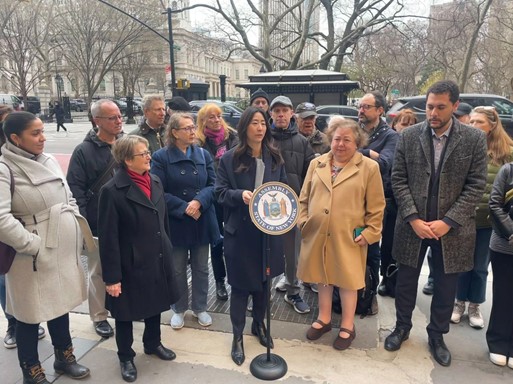Assemblymembers Deborah J. Glick and Grace Lee, Senator Liz Krueger, Councilmember Christopher Marte, and Community Leaders Hold Press Conference in Opposition to FAR Cap Removal
Assemblymembers Deborah J. Glick, 66th Assembly District, and Grace Lee, 65th Assembly District; Senator Liz Krueger, 28th Senate District; Council Member Christopher Marte, 1st City Council District; and community leaders held a rally outside of legislative offices at 250 Broadway to oppose the proposal to lift the Floor Area Ratio (FAR) cap on the size of residential buildings in New York City.
A FAR cap was originally instituted in 1961, and current regulations mandate the maximum square footage for residential buildings cannot exceed twelve times the size of the square footage of the parcel of land the building is sited upon. Over the last six decades, New York City has seen an explosion of residential development with very little investment in affordable housing. Development under this limit has led to a surge of luxury units and a simultaneous shrinking of affordable unit stock.
Despite the laudable intention of spurring the creation of affordable units, lifting the FAR cap will lead to ever taller towers and will not guarantee any meaningful increase in affordable housing.
Assemblymember Glick said, “Under the current FAR cap, supertall towers are being built to give the wealthy views from 1,500 feet above. Rather than letting developers build ever higher, we should be looking at the large stock of unutilized office, hotel, and commercial space that can be converted into new affordable housing. The Legislature has successfully pushed back on this proposal for the last several years, and we must make certain that developers are not given a green light for more luxury development.”
“To address New York’s housing crisis, we need to ask ourselves what kind of housing needs to be built and for whom,” said Assemblymember Grace Lee. “The proposal to lift New York City’s FAR cap is woefully inadequate if it does not include any guarantees to create truly affordable housing and job opportunities for New York’s union labor workforce. Without these assurances, a higher FAR cap risks greenlighting the production of more luxury high rises that will not serve the needs of low-income and working-class New Yorkers. I join Assemblymember Glick and my colleagues in rejecting the proposal to lift the FAR cap.”
Senator Kruger said, “Rather than being the panacea for affordable housing that some claim, removing the FAR cap would likely lead to the demolition of affordable homes and increase displacement pressure on tenants. As we’ve seen over and over again, the construction of more supertall towers has actually led to a loss of affordable housing as smaller buildings filled with affordable rent regulated and lower cost market rate units have been demolished and replaced by ultra-luxury apartments for the richest of the rich – or investment vehicles for foreign oligarchs. Our job in Albany is not to create a boon for developers who want to build supertalls in one of the densest population centers on the planet, that will do nothing to move the needle on affordability. We need real solutions.”
“History shows that big private developers build too small a percentage of marginally affordable units; lifting the FAR cap would give them a blank check. Brooklyn is all too familiar with broken promises from developers who claimed they would build affordable housing, such as the Atlantic Yards project, only to end up never completing those projects after receiving massive tax breaks and subsidies and pushing out 25% of the Black community from the very community boards that were slated to receive a preference for the so-called ‘affordable’ units,” said Assemblymember Jo Anne Simon. “Developers already use every loophole to evade the current 12 FAR cap, including ‘mechanical voids and unused floor space. The real estate industry has argued that ULURP would still be required and community boards have a vote, but ULURP has no community teeth and developers know it. We need solutions to our housing crisis that focus on creating real affordable housing and keeping people in their homes right now, not unrestricted development of luxury towers that cater to the wealthy."
"Lifting the FAR cap will only allow for more luxury supertall developments and do nothing to address the affordable housing crisis,” said Council Member Christopher Marte. “Density restrictions are not the issue; there is plenty of developable area across the city. The issue is that developers choose to build luxury condominiums over truly affordable housing and lifting the FAR cap will only exacerbate this. We need policies that demand housing that our communities can afford, not giveaways to the real estate industry."
“Removing the FAR Caps doesn’t just affect the height of a building, it also affects the bulk. It’s the reason many tall apartment buildings have green spaces with trees and gardens. Without those limitations, tall buildings can be built right up to the sidewalks, allowing for a dystopian hell of a City with people living in tiny apartments looking out their windows at other people looking back from their tiny apartments. No views, no trees, no gardens, no sunlight, no birds, no squirrels, just us, the rats and the roaches,” said Kathryn Freed, former City Council Member for District 1.
“The proposal to lift the FAR cap would only enrich developers while destroying neighborhoods and existing rent-regulated affordable housing, displacing longtime residents and accelerating gentrification,” said Andrew Berman, Executive Director of Village Preservation. “The plan doesn’t require a single unit of affordable housing but will ensure more of the massive supertalls that house sprawling triplex fourth homes for the globetrotting super rich get built. What proponents of this plan fail to disclose is that it’s been on Big Real Estate’s wish list for decades and creates huge financial incentives to demolish existing rent regulated housing, which disproportionately shelters longer term residents who are older and less well off than average, and who will lose their homes as a result.”
"Removing the FAR 12 cap on new development would override guardrails in the NYC Zoning Code,” said Michael Kramer, President of the Seaport Coalition. “Imposing a blanket solution to add more density to Lower Manhattan should be a non-starter."
"The Municipal Art Society is committed to the increase of affordable housing in New York City. We seek a holistic plan to housing New Yorkers that delivers all the assets that communities deserve -- from affordable homes to transportation to parks and libraries,” said Elizabeth Goldstein, President of the Municipal Art Society of New York. "Significant unused floor area is available today across the city, which can be put to use now without raising the FAR Cap. New Yorkers deserve a well thought through and comprehensive approach to increased housing that delivers great quality of life."
Historic District Council Executive Director, Frampton Tolbert said, “Creating and preserving affordable housing in our city is a critically important goal that the Historic Districts Council strongly supports, but we believe that lifting the FAR Cap will not help us meet this goal and would only impact a small portion of the city. Instead, we should be focusing on other solutions such as changes in policy to allow for commercial to residential conversions in NYC, which would both help create new housing and also help us achieve sustainability goals through retention of existing buildings and not allowing for massive demolition and loss of embodied carbon.”
“What we want and need is more smartly designed affordable housing, construction that respects the surrounding neighborhood and its residents, and a sensible approach to urban planning in NY,” said Robert Moses, President of Lower East Side Preservation Initiative. “What we don’t want is more blanket rezonings, more false promises of how hi-rise luxury construction will make our city more affordable, and more efforts to undermine the basic livability of our city in order to line developers’ pockets. And we say no to the governor’s current proposal to remove the state’s floor area ratio cap, which will do nothing but allow sky-high luxury buildings to grow like oversized weeds all over New York.”
“Two years in meetings with State agencies and developers as part of the Coalition for a 100% Affordable World Trade Center Tower 5 has made one thing clear – the higher the building the faster the costs go up,” said Richard Corman, President of Downtown Independent Democrats & member of the Coalition for a 100% Affordable World Trade Center Tower 5. “While 5 WTC is a unique situation on public land, we’ve been told the cost of the planned 80 story tower would be $1 million per apartment. Lifting the FAR cap is not the path to an affordable New York and will only create more unaffordable housing.”
“We are in opposition to any more plans that will cause more displacement than we are [already] facing,” said Tanya Castro-Negron, Chair of Lands End 2 Resident Association Board of Directors and representative of 937 residents. “Let’s choose to provide a better plan for these proposed developments before we provide more incentives to these gentrifying proposals…There is and has been a lack of accountability on the part of Real Estate and luxury developers. The current EIS and/or ULURP requires a minimal level of preventive measures to protect against the displacement of residents and communities at large. Preservation of homes should be the priority over allowing developers to build higher.”

